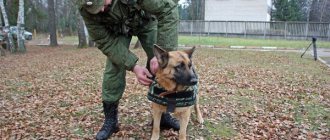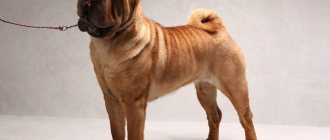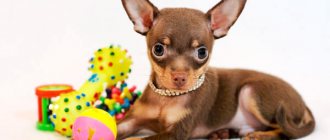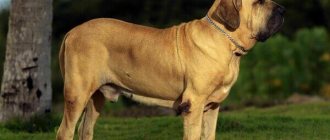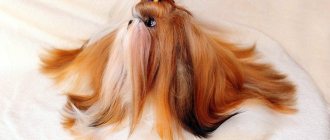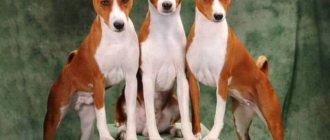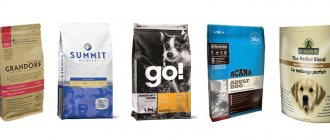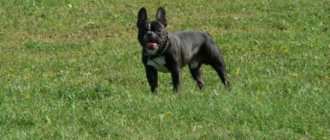- Lifespan : 13-14 years
- Weight: 6-8 kg
- Height (height at withers): 28-32 cm
- Puppy price: from 8 to 35 thousand rubles
They say about pugs that these dogs represent a lot in a little. Indeed, miniature size is in harmony with powerful muscles, a loving disposition is combined with a willingness to protect the owner, and laziness is quickly replaced by playfulness. Many owners consider these miniature Molossians to be people. They are right in their own way: the monkey’s face, expressive facial expressions, paws that resemble hands, and the breed’s high empathy make them treat dogs as equals.
Basic moments
- One of the best breeds for keeping in the city and in an apartment
- Suitable for people with different lifestyles
- Loves children
- Gets along with other pets
- The pug breed is easy to care for, but monitoring nutrition and health takes a lot of time, effort and money
- Not aggressive
- Loves everyone: owner, family members, children, strangers, animals
- Suitable as a first dog
- Does not require intense physical activity
- The pug is smart, but due to its stubbornness it is difficult to train
- Cannot tolerate heat and cold
- Due to the brachycephalic shape of the head, problems with the respiratory and cardiovascular systems are common.
- The pug hardly barks, but makes many other sounds: whistling, snoring, grunting, muttering
- Prone to obesity and allergies
- May be jealous of owner towards other people and animals
- Can't stand loneliness
- In the 18th century in France, pugs were called carlens: for the black mask on their face, similar to the one worn by the hero of the comedy “Harlequin of Karlen”
- In 2004, a representative of the breed received the title of best dog at the World Dog Show.
Useful video
From the video you will learn about the pug dog breed and whether it is worth getting one:
2018-10-01Photo gallery
Pug - for people with a passive lifestyle
17.10.2010Advantages:
Gentle, loving all their owners at once, great kissers, very loyal.
Disadvantages:
careful feeding, large eyes, they need to be protected from sharp objects: branches, sticks, twigs and cat claws. I bought myself a female pug, with a brand and pedigree, the name Gentil (Zhanya).
You know, pugs are very kind animals, mine has never bitten me in a whole year of its life, this speaks of its devotion and respect... Read full review Review recommended:
164
Little miracle with big eyes (many photos)
09.01.2013Advantages:
very funny, smart
Disadvantages:
none; After our beloved cat, who lived with us for 16 years, died, I was sure that I would never have animals.
But the son said that he wanted a dog and chose a breed that is ideal for... Read full review Review recommended:
114
A small, pop-eyed miracle!
09.06.2011Advantages:
Affectionate, devoted, obedient. The best!
Disadvantages:
Problem with a fold on the nose - needs to be washed...and snores...Since early childhood I have had no luck with dogs.
They ran away, they stole, they died. Everything was somehow bad. But I couldn’t come to terms with the fact that my dream of a dog would never come true... Read full review Review recommended:
52
Best breed
31.01.2012Advantages:
Kind, smart, energetic
Disadvantages:
none found; Let's start with the fact that we have a lot of dogs.
But most of all I love one – Pug. This is a wonderful breed. No matter what anyone says, I can’t say that they are picky. She eats absolutely everything... Read full review Review recommended:
30
Little funny bun
09.09.2016Advantages:
Beautiful, the funniest and most cheerful breed, kind, affectionate, clean, not stupid
Disadvantages:
Requires great attention and care, snores in its sleep Meet me!
Umnessa Corso Delas An incredibly playful and sweet pug) I raised her from the “cradle”))) But now she doesn’t live with me, unfortunately, but lives with my mother. Since I got married... Read full review Reviews recommended:
149
Best friend “electric broom”, or how to cure depression!
12.09.2012Advantages:
Good-natured disposition, loves children, easy to care for, compact (which is also a plus)
Disadvantages:
No matter how often she scratches, there will still be fur around the house! 2010 was a difficult year for me, and, worst of all, my long-awaited pregnancy was terminated.
Depression overwhelmed me, and in order to somehow distract myself, I decided to get a dog, especially since I had wanted a pug for a very long time. The entire break... Read full review Review recommended:
24
Good as a companion or friend for a child
11.06.2015Advantages:
Calm disposition, flexible, friendly character.
Disadvantages:
Expensive pleasure. We don’t have a dog in our family and don’t have any plans for now, due to the small living space, but we are still very familiar with a pug dog.
The pug puppy was given to my daughter by her godmother for her 5th birthday, three years ago... Read full review Reviews recommended:
31
Big child)
21.06.2014Advantages:
Playful, kind, snorer)
Disadvantages:
None. The pug dog is probably one of the cutest and most relevant breeds in our time.
No matter who you listen to, everyone wants a pug. However, not everyone understands what to do with these dogs. This is why there are bad reviews... Read full review Review recommended:
40
The dog is wonderful, quickly became a member of the family
19.10.2014Advantages:
pugs are kind, cheerful, gentle and intelligent
Disadvantages:
none To anyone who is thinking about purchasing a pug dog, I want to say that you will not regret it.
Very good breed. When we were thinking about getting this breed, at first we read a lot about this breed. There were both positive and... Read full review Review recommended:
131234567891011>
Pug breed standard
The latest edition of the FCI standard, number 253, was approved in 2010. According to him, the pug belongs to section 11 - small Molossians, group 9 - toys and companions.
The description of the breed characterizes the pug as “a lot in a little.” This is a small dog of a dense and well-built physique, with strong bones and developed muscles. Characteristic features of appearance are a square format, a brachycephalic head shape, a short muzzle and pronounced wrinkles on the muzzle.
The height of females varies from 25 to 30 cm, males - from 28 to 32 cm. The ideal body weight is considered to be in the range of 6.3-8 kg, but recently there has been a tendency for the breed to become heavier. Therefore, girls often weigh 8-10 kg, boys - 10-12 kg .
Head
Large, massive, but proportional to the body. Slightly round, but an apple shape is not acceptable. The skull is without depressions or bulges, with a flat forehead. The muzzle is short, square, flattened. There are pronounced wrinkles on it: coupled with expressive facial expressions, they make the pug look like a monkey.
Jaws and teeth
The pug's jaws are wide and the bite type is undershot. The length of the lower jaw is equal to the width of the skull. The incisors on it form an almost perfect straight line.
The lips are fleshy. When the mouth is closed, they hide the teeth and tongue. Pigmentation is black.
Nose
Flat. The lobe is large, black. The nostrils are well opened.
Eyes
Large and round, slightly bulging. They stand low, wide and straight. Eye color is dark, eyelids are black.
The pug's expression is touching, sensual, as if slightly tired. When excited, the look is interested, full of brilliance.
Ears
Set wide and high. Thin, small, rounded at the ends. They feel like velvet to the touch. Pugs come in two types: rose and button. The latter is preferable, because it makes the skull appear more massive.
Neck
Massive and short, but long enough to hold a pug's head. Curved like a ridge. The skin on the neck is pulled back freely, covered with small folds that form a dewlap.
Frame
Tightly folded, short, square in format. The back is muscular, straight, without bends, with pronounced withers. The belly is moderately tucked, the chest is wide, deep and round.
Limbs
Straight, parallel, placed under the body. The limbs are strong and of moderate length: the dog appears neither short-legged nor long-legged. Elbows are facing back and pressed to the body.
The pug's paw type is intermediate between a hare's and a cat's. Slightly long, gathered into a ball, fingers clearly separated. Claws and pads are black.
Tail
Stands high, tightly pressed to the croup. It gathers into a tight ring above the thigh. In pugs, a double curl is desirable, but a single curl is also acceptable.
Wool
Adheres tightly to the skin. Short, straight and thin. Rigidity or fluffiness of the hair is not allowed. Characterized by shine and silkiness.
Defects in appearance and disqualifying defects
When evaluated in the ring, a pug is fined for the following deficiencies:
- not fully opened nostrils;
- excessive folds on the muzzle;
- jaw misalignment or straight bite;
- visible teeth and tongue with the mouth closed;
- bulging eyes;
- coarse or fluffy fur;
- prominent forehead;
- long or insufficiently wide muzzle;
- protruding chin;
- light eyes;
- tail standing low or insufficiently curled;
- insecure or nervous behavior.
Disqualifying defects for which a pug is excluded from exhibitions and not allowed for breeding:
- aggression;
- cowardice;
- weight up to 6 kg;
- height below 25 cm and above 32 cm;
- elongated torso;
- depigmentation of the nose, lips, eyelids;
- shaved;
- fishy, small or bug-eyed eyes;
- undershot or scissor bite;
- weak, long, sloping, sagging or convex topline;
- straight, short or drooping tail;
- paws spread apart or clubfooted;
- light nails;
- barrel chest;
- high-legged, squat, raised withers or croup.
Pug colors with photos
Pugs are allowed 4 colors : beige, apricot, silver and black. With the first three, contrasting dark markings are required:
- face mask;
- “diamond” in the forehead: a black dot resembling a fingerprint;
- “moles” on the cheeks;
- belt on the back;
- darkened ears.
Below we describe in detail all the colors of pugs with photos.
Beige color
The second name is Fawn. Includes all shades of yellow and brown. There are more dogs with this color, although the beige color is recessive. The eyes are rich brown.
Apricot color
In English - Apricot. Less common than beige color. It is also called deer or red.
The beige and apricot colors of pugs are often confused. The main difference is that in the second type the hairs have a rich red color.
Important! The full Apricot color in pugs is formed by the age of 1.5 years, when two seasonal molts occur. The puppy's initially pronounced red color may become overcolored and turn pale.
40 breeds with red color.
Black color
Black color is the rarest color among pugs. Puppies of this color are very valuable and expensive. Dark wool can become dull and fade over time. To prevent this from happening, do not walk the dog in the sun and wash it with special shampoos that retain color.
Pugs of this color are not allowed to have light areas: white, red, beige, gray. Claws, edging of eyes, lips, eyelids should also be deep black. Only a snow-white spot on the chest is allowed. But when judging, priority is given to all-black dogs.
Silver color
Also Silver fawn or "moon fawn". The color was recognized later than others, so dogs of this color are rare. In Russia, silver pugs are not yet allowed for exhibitions, but in Europe and the USA such dogs are popular.
The peculiarity of the color is not a pure gray color, but the presence of beige or light brown hairs. Mixing and shimmering, they form a steel tint, which is visually perceived as a silvery tint.
Reviews for analogues:
Dry food for adult pug dogs Royal Canin Pug Cartoon “Friendly Pugs” (2017) Danshen Gouliang Chips “Black Pug” Breathable toy Perfect Petzzz “Pug” Closed muzzle for pug TRIUMPH
Almost every pug owner can attest that they are more than just a dog. Always cheerful, sociable, sociable, playful and affectionate. However, there are those who are absolutely sure that a pug does not always bring only positive emotions.
The purpose of this article is to sort out the pros and cons of the breed, and also to sum up the final result: is it worth getting a pug?
Pug weight by month
The ideal weight for an adult dog ranges from 6.3 to 8.1 kg. But recently, breeders have given preference to heavier dogs: 8-9 kg for females and 10-12 kg for males. Pugs with this weight have more successful matings and are easier to bear and give birth to puppies.
Intensive growth is observed up to 9-12 months, although some pugs develop and build muscle up to 1.5 years. Puppies gain weight especially actively until they are 4 months old. From six months the increase is ¼ of the total weight monthly.
Below is a table of weights by month for pug puppies. Using it you can control the development of your pet:
| Puppy age | Pug weight by month | |
| Bitches | Males | |
| At birth | 150—250 g | 150—250 g |
| 4 weeks | 0.9—1.1 kg | 0.9—1.1 kg |
| 2 months | 1.9—2.1 kg | 1.9—2.1 kg |
| 3 months | 2.9—3.1 kg | 2.9—3.1 kg |
| 4 months | 3.9—4.1 kg | 3.9—4.1 kg |
| 5 months | 4.9—5.1 kg | 4.9—5.1 kg |
| 6 months | 5.8—6.2 kg | 5.8—6.2 kg |
| 7 months | 6.3-6.8 kg | 6.8—7.2 kg |
| 8 months | 6.8-7 kg | 7.8—8.2 kg |
| 9 months | 6.9—7.3 kg | 8.8—9.2 kg |
| 10 months | 7.3—7.6 kg | 9.9—10.1 kg |
| 11 months | 7.6-8 kg | 10.9—11.2 kg |
| Year | 8-9 kg | 11.9—12.1 kg |
Additional Information! The indicated values are approximate: deviations of 300-500 g up or down are acceptable. It is advisable to weigh your pug puppy every week during the first month to monitor weight gain. In subsequent periods, 1-2 weighings per month are sufficient.
Photo gallery
Look into those kind eyes, how they can hurt someone. These dogs are able to add a positive mood even on cloudy days by playing with their household members.
Pug character
Pugs compare favorably with other decorative breeds in their character. They are not demanding and not intrusive. At the same time, they are excellent friends and family members, whose affection and cheerful disposition make even the most stormy days joyful.
Pugs get along in any family. Their cheerful, gentle disposition, coupled with their unobtrusiveness, make dogs excellent companions for singles, couples and the elderly. The breed is not suitable only for very active people and people who work a lot and are away from home for a long time. Dogs do not tolerate separation well. They miss their owner, and upon their return they put on a show: they jump, climb on arms, lick and “dance” on their hind legs.
Pugs get along with everyone. They become best friends and nannies for children. Dogs will never hurt children: on the contrary, you need to keep an eye on the children so that they do not injure the animals.
Small Molossians also get along with other pets. Not against the company of dogs, cats, rodents and birds. But only if they are the main ones in a variegated “pack”, and the owner does not deprive them of attention.
Pugs are friendly with strangers, although they treat passers-by with some caution. Unreasonable aggressiveness occurs only in poorly trained and unsocialized dogs.
Interesting fact! Pugs use their paws like hands. When asking for food, they stretch out their front paw and move their fingers; they also pull out toys from under the closet or bed with their paws and know how to open doors. Therefore, dog owners often call their limbs arms or legs.
Up to 2-3 years of age, pugs are very playful, although they are not particularly active when compared with active breeds. With age, dogs become more imposing: they prefer to spend time on the sofa next to their owner. But pets are not at all lazy: they love to participate in household chores and are not averse to playing pranks.
The plus of pugs is that they rarely bark, the minus is that they make a bunch of other sounds: they whistle, grunt, squeal, mumble and “talk”.
The nature of the breed makes the pug an ideal dog for the city and apartment. He is suitable as a first dog. But be careful: once you get a little “monkey,” you will certainly want another one.
How to choose a puppy
Buying a pug puppy is not difficult - this breed is very popular and does not belong to the rare category. You should not buy a baby on the market or on the Internet, because in this case no one will give you a guarantee about the purebred and health of the puppy. There are many kennels that breed pugs. The breeder will show the puppy's parents, share contacts of buyers who purchased babies from this or previous litters, issue the necessary documents confirming purebredness, and a purchase and sale agreement.
Puppies should be observed for some time. Experts advise choosing the most active and good-natured baby. He should be cheerful, clean and well-groomed. Festering or watery eyes, nose, ears, matted, dull fur are symptoms of a disease.
As for the cost of pugs, purchasing in large cities will cost $250-750 (depending on the exterior class). In small cities, the cost of puppies is lower - $160-450.
Care and maintenance
The pug is the ideal lap dog. A small apartment will suit him, and instead of a couch he will prefer to sleep with the owner on the bed. The dog will also get along outside the city, but it cannot be left in the yard for a long time or kept in an enclosure: the pet is not adapted to street life.
And if easy maintenance is a plus of the breed, then difficult care is a significant minus. Your pug needs to be constantly monitored. He is easily injured while playing or exploring the territory, and an unbalanced diet or insufficient care will lead to numerous diseases and shorten the pet’s life.
Hygiene
Pugs are naturally clean. They don't like to wallow in mud. And if they accidentally get dirty, they worry and try to clean the coat as quickly as possible. But, like any breed, doggies need regular hygiene procedures.
Key points on how to care for a pug:
- Combing. Pugs have short hair. But it pours out abundantly. Brush with a brush with short metal teeth: during the molting period - every day, at other times - 2-3 times a week.
- Bathing. You don't need to wash your dogs often. Pugs are bathed once every 1.5-3 months. After walks, wipe the paws, underbelly, and soiled fur with a damp sponge.
- Caring for the fold on the muzzle. Dust, food debris, dirt and debris from the street, and discharge from the eyes and nose constantly accumulate between the wrinkles on the head. Wipe the fold at least once a week with a sponge soaked in chlorhexidine or veterinary lotion. At the end of the procedure, you can lubricate the indentations with Vaseline to moisturize them and protect them from damage.
- Ear cleaning. The erect ears of pugs hardly get dirty. But plaque is removed from them every week, and after walks they are inspected for ticks and dirt.
- Cleaning teeth. Due to their flattened muzzle, plaque accumulates on them abundantly, and caries often develops. Teeth are cleaned 1-2 times a week with a brush for small dogs and veterinary paste. The rest of the time they give toothpicks treats. Also, once every six months to a year, the stone is removed using ultrasound in the clinic.
- Nail trimming. Trim with a nail clipper for small breed dogs once a month. Carefully cut only the first third so as not to damage the blood vessels.
- Eye care. Pugs' large and slightly protruding eyes are easily injured, inflamed and dirty. They are inspected every day, and nitrous is removed as necessary. A veterinary solution is also given weekly to clean the eyeball and prevent infections.
Toilet
Until the post-vaccination quarantine is over, the puppy cannot be taken outside. Therefore, he is taught to go to the toilet in a diaper or in a litter tray. Fortunately, pugs are smart: in 2-3 weeks they learn to relieve themselves in the right place.
Immediately determine where the tray will always be located. Place a diaper in this area. If the room is large, place it near the bed and gradually move it to the place of the toilet.
In the first days, carefully monitor the puppy. As soon as he starts spinning in place, take him to the diaper. When he relieves himself, praise him. If your baby peed in the wrong place, don’t scold him, just soak a rag in it and put it in the toilet’s place. Wipe the puddle with vinegar or a special disinfectant.
As soon as the kitten begins to walk steadily on the diaper, put it in the tray. The first time the baby will have to be placed there, but after a couple of days he will understand what to do.
From the age of four months, pugs are taught to go outside. For the first times, take a diaper with you and lay it on the ground: the smell will tell the baby what to do. It is advisable for the dog to relieve himself first and then play.
Up to a year, the pug is taken outside often: 5-6 times a day. At this age, kids can't stand it. Therefore, a home toilet will come in handy.
After a year, pugs learn to tolerate it and can be taken outside 2-3 times a day . But the toilet at home is still useful: in case the dog cannot be taken out for a walk due to lack of time, illness, bad weather, or simply so that it relieves itself as soon as it wants.
Feeding
How to feed a pug puppy.
Proper and balanced nutrition for a pug is a key factor in the pet’s health and longevity. The breed is demanding when it comes to feeding, so this aspect is given a lot of attention.
Note! When feeding pugs, it is important to maintain the correct balance of calcium and phosphorus. Their deficiency or imbalance leads to diseases of the nervous, cardiovascular and digestive systems.
A tendency towards obesity and begging are characteristics of the breed. It is important for owners to understand that by overfeeding or giving tasty morsels from the table, they shorten the life of their pet. Therefore, the portion size is limited and the pug is not spoiled with prohibited foods: sweets, cheeses, sausages, semi-finished products, etc.
For pug puppies up to 6 months of age, the daily dose of food is 5-7% of the dog’s weight. For dogs older than six months - 3-4% of their own weight. So, if the kitten weighs 4 kg, 200-180 g, divided into several feedings, will be enough. For an adult dog weighing 8 kg, 240-320 g per day is enough.
Such calculations are followed on natural feeding. In this case, the diet consists of lean meat and offal (60%), cereals (20%), vegetables and fermented milk (15%), other products: eggs, fruits, delicacies.
Often, pug owners choose to feed them with industrial food, because the breed is picky about food and it is difficult to balance natural nutrition.
When selecting ready-made food, take into account that the pug is an allergenic breed. Therefore, diets should not contain gluten (found in wheat and corn), soy, casein (milk protein), dyes, flavors, and artificial preservatives.
Super-premium and holistic class foods meet these requirements. The best brands for pugs:
- Piccolo: Small Dogs;
- Applaws: Dog Small & Medium;
- Alleva: Holistic, Dog Mini;
- Acana: Heritage, Small Breed;
- Primordial: Dog Mini, Holistic;
- Farmina: Natural & Delicious, Dog Mini;
- Barking Heads: Doggylicious
- Ava: Adult Dog Fresh Meat Small.
Additional Information! Some pugs are allergic to chicken. Therefore, look for ready-made food without this ingredient or with poultry raised using organic raw materials, without hormonal additives.
You can also choose food to suit your pet’s specific needs. Typically, pugs need hypoallergenic food for teeth cleaning, sensitive digestion, or weight control.
Walks and trips
The pug is considered a classic couch dog. Because of this myth, many owners neglect physical activity. But this approach is fatal. The breed has developed muscles. Lack of movement leads to poor circulation and muscle atrophy. Plus, without regular exercise, dogs quickly gain weight, the excess of which affects their health.
Walks should be daily. However, long walks and intense games are prohibited. Pugs get tired quickly, and the structure of their muzzle does not allow them to effectively cool the body and fully saturate the blood with oxygen during exercise.
Puppies up to 6 months old are taken outside 5-6 times for 15 minutes. Juniors from six months of age are walked 4 times for 20 minutes. For adult dogs, 2-3 walks a day for 30-40 minutes will be enough.
The optimal walk with pugs is a leisurely walk. You can run or play with them, but no more than 15 minutes at a time: the less than ideal respiratory system affects them.
Walking in hot and cold weather has its nuances. In summer, a pug quickly overheats: do not take your pet out into the heat and stay in the shade of trees. Bring a water bottle with you to water your pet periodically. From mid-autumn to early spring, you need waterproof and warm clothing: blanket, overalls, hat, shoes. Also in winter it is advisable to reduce the walking time to 20 minutes.
The situation with joint trips is ambiguous. On the one hand, pugs cannot tolerate separation. On the other hand, they also have difficulty with moving and heat, and they often get motion sickness. If you decide to take your pet with you, make sure that the compartment or car has air conditioning. Also bring plenty of drinking water, canned food, dog bedding, wet wipes, and paper towels.
When planning a trip, you take into account the length of the trip, the well-being and character of your pet. Some pugs can withstand a couple of days on the road, others cannot stand even a few hours. Sometimes it is better to leave the dog with friends: he gets along even with strangers and can easily survive a short separation if you take good care of him.
What should a novice trainer remember?
To prevent training from turning into torture, you need to consider a few more points:
- Any workout can be made easier. To do this, you need to take your pet for a good walk in advance. A tired, running dog will be less distracted. This means the effect will be greater. According to experienced owners, active walking makes working with the animal several times easier.
- Each command is spoken only once. They cannot be duplicated. The dog quickly grasps, if he understands that the owner can repeat the same thing several times, then he will stop performing the technique the first time.
- There must be pauses between teams. When practicing, for example, “near”, “lie down”, “fetch”, you need to give the dog time to take a breath. 5-10 seconds will be enough. If you do not pause, the dog may simply become confused.
- It's important to change the sequence. During training, it is better to practice all techniques separately. If the dog gets used to doing everything in order, nothing good will come of it in the end. Unless he develops a reflex. That, for example, after “to me” you need to “sit.” The dog must master commands in any sequence.
- You cannot overload your student. Too intense training can harm your four-legged friend. We must always keep in mind that a dog is a living creature. She may have some pain. Or not being in the mood to study.
An already trained dog is able to perfectly carry out commands under any conditions. But we must keep in mind that your pet may get tired.
- Sometimes students, like ordinary schoolchildren, “run away from class.” They may be distracted by a nearby cat or other dog. This can be avoided if you are more careful about exposure. Train her on a long leash. This will allow you to catch up with the “mischievous person”, even if he runs fast. A leash with a carabiner for 3-5 meters is suitable. Often such a leash is just needed for endurance and training to pick up “goodies” from the floor.
- “Mass” training is not allowed. Only the dog's owner should act as a trainer. The dog must obey all family members. And pets must master the basic principles of raising an animal. But at the training itself there are only two people: the owner and his pupil. Otherwise, the dog will be constantly distracted.
- Sometimes during training it is worth pausing. It happens that the dog looks scared. He follows commands, but seems to doubt the correctness of his actions. The reason is usually that the owner was too strict and overdid the load. In such cases, you need to get the dog to fulfill the simplest command for him, and then generously praise him. More than usually. The dog, seeing that the owner approves of him, will begin to perform the exercises better. You can even play with the dog or take it for a walk.
- To develop the ideal execution of techniques, they need to be studied systematically, gradually. It is necessary to teach your pet to follow commands in any conditions. Start with perfect obedience in a calm place, gradually adding “stimulants”. They can be created artificially. For example, scattering treats. Or invite a friend to walk past your training place at a certain time. You can come up with “irritants” yourself or read reviews from experienced owners.
Education and training
Pugs are smart and pick up commands on the fly. Therefore, in the first weeks of a puppy’s life in a new home, he can be taught basic orders: “Ugh,” “No,” “Come to me,” “Place,” “Stand,” “Sit,” “Lie down.”
The first thing a pug kitten must learn is its name. Without this, subsequent training will not be effective. The second most important lesson is the commands “Fu”, “No” and “Drop”. The dogs are friendly and curious, picking up food from the ground and taking treats from the hands of strangers. Knowing the prohibitory orders will protect your pet from poisoning and harmful treats.
Mastering more complex commands is difficult. The pug breed is stubborn, does not like to obey, and is often on its own mind. Therefore, you will have to make a lot of effort to train a small Molosser.
If you are at a loss on how to raise a pug, be consistent. Even if your pet doesn’t master the command for weeks, don’t give up: one day he will understand everything and will obey. Be patient. Stubborn monkeys can be won over with affection and constant encouragement. Any punishment during education is unacceptable, even raising your voice is prohibited. You can only scold your pet if he does something wrong.
Feeding
Another advantage is the ability to feed your pug a variety of foods. Dogs equally love both natural food and dry food.
To keep your pet healthy and cheerful, do not skimp on its nutrition.
If the dog’s main diet is natural food, then try to supplement the menu with fresh meat, vegetables, cereals and bread. Try to give your dog raw meat, as it is quite nutritious and contains many useful substances.
Health and illness
Pugs are not the strongest breed. Throughout their lives, they are constantly faced with hereditary and acquired diseases. How long doggies live depends directly on genetic health, care and proper nutrition. Usually pets reach 12-13 years of age, some individuals live up to 15 years.
Common diseases in pugs include:
- encephalitis;
- epilepsy;
- eye problems: injuries, infections, chronic retinal erosion;
- pathologies of the respiratory system;
- respiratory diseases;
- cardiovascular diseases;
- obesity;
- allergies: to flowering plants, dust, food, cleaning products;
- infection of the skin fold on the face;
- Plaque, cavities and crooked teeth: A flat muzzle causes canines, incisors and molars to be too closely spaced, which often causes problems.
Also, due to their brachycephalic muzzle, pugs are prone to flatulence and snoring. But the second, contrary to popular belief, is rare. Usually dogs just snore in their sleep. And during the day they puff and grunt.
Origin story
The homeland of the pug is China. His ancestor is considered to be the “Lo Jie” breed, which had short hair and resembled a Pekingese.
The owners of this breed were usually noble, rich people. The Chinese believed that the folds on the animal's forehead constituted a hieroglyph, which was called the imperial sign.
The pug appeared in Europe four centuries ago thanks to Dutch sailors. There, both ordinary people and royalty fell in love with him; they called him the “Chinese Mastiff.”
There is a well-known legend in which a pug saved his owner, the King of Holland, from death. At night the Spaniards attacked the camp, and the dog barked and scratched the floor to wake up the owner. After this, the pug became the official dog of the royal dynasty for the entire 16th century. In the same century, these animals gained popularity among the ladies of the court, they believed that having a pug was honorable and obligatory.
It is known that Napoleon’s wife loved her pug very much, and appeared everywhere only with Fortune.
The breed appeared in Russia in the early 80s. The first producers were the German Aron von Divan and Nineta von Elbflorenz. In the late 80s, Tootsie Hondius, Biba with Orchid, Hagab Istamnoslekit and Tsarina were brought from Poland.
Pug

